7 Awesome Activities for Visual Perception in 2025
July 12, 2025
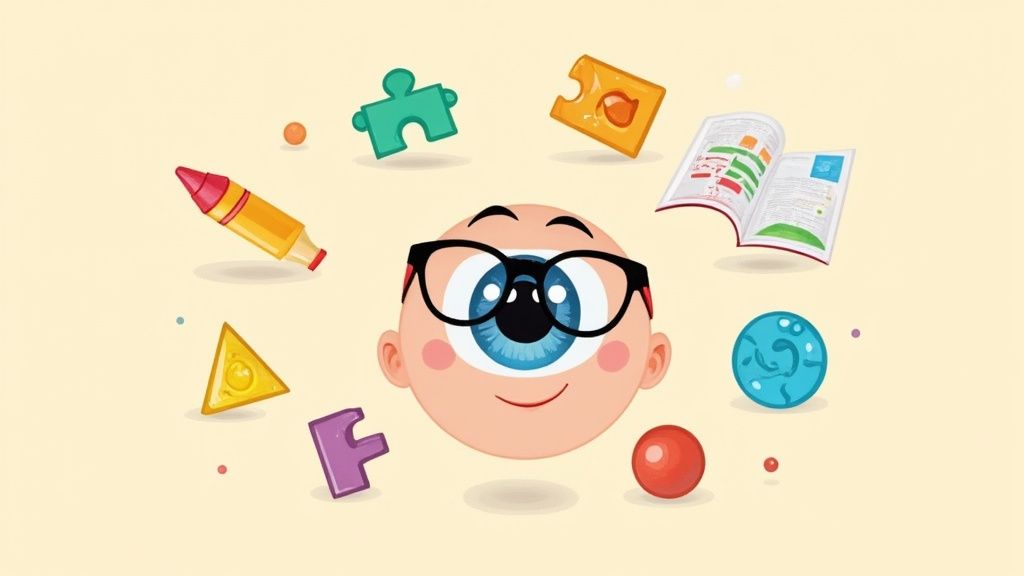
Ever tried to build IKEA furniture using only the diagrams? Or navigated a packed grocery store to find that one specific brand of ketchup? That’s your visual perception at work. It’s not just about what your eyes see, but how your brain processes and makes sense of that information. Think of it as your brain’s ability to interpret a complex visual puzzle, whether that’s recognizing a friend in a crowd or judging the distance to step off a curb safely.
This ability isn't a single skill but a team of them working together. Skills like visual discrimination (telling the difference between "b" and "d"), figure-ground perception (spotting a toy in a messy room), and spatial relations (knowing if you can fit your car in a parking spot) are all crucial parts of daily life. Strengthening them doesn't have to feel like a chore.
This guide is packed with fun, hands-on, and accessible activities for visual perception designed for everyone from kids to adults. We'll explore everything from pattern blocks and tangrams to hidden picture games that feel more like play than practice. These exercises are not just for developmental support; they are foundational for learning, creativity, and maintaining mental sharpness at any age. Indeed, many of the activities discussed here fall under the umbrella of essential cognitive activities for elderly people, highlighting the critical role visual perception plays in overall brain health. Let's dive into some engaging ways to sharpen these vital skills.
1. Build and See: The Power of Pattern Block Activities
Pattern blocks are one of the most versatile and effective activities for visual perception you can have in your toolkit. These colorful geometric shapes, including hexagons, squares, triangles, and rhombuses, are far more than simple toys. They are powerful tools for teaching the brain to understand spatial relationships, recognize shapes, and integrate visual information with motor skills. By manipulating these blocks, children learn to see how individual shapes can combine to form a larger, more complex picture.
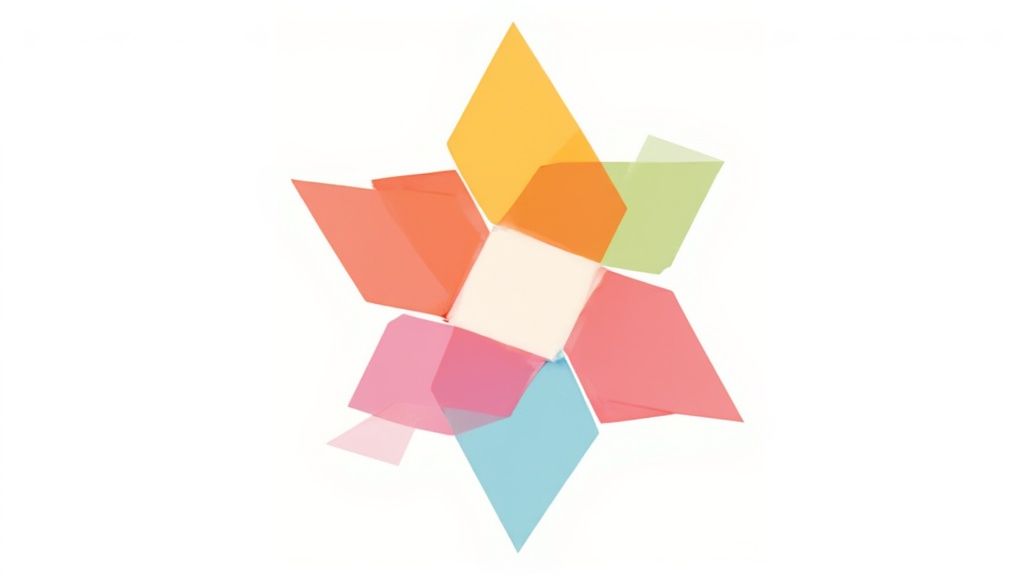
This hands-on process directly strengthens key visual perception skills like visual discrimination (telling shapes apart), spatial relations (understanding how objects fit together in space), and visual closure (imagining the completed whole from its parts). The tactile nature of the blocks also builds crucial visual-motor integration, which is the ability to coordinate hand movements with what the eyes see.
Why This Works So Well
The magic of pattern blocks lies in their structured yet creative nature. They provide concrete, movable representations of abstract geometric concepts. This approach is widely celebrated in educational philosophies like Montessori and is a staple in occupational therapy clinics, where they help individuals develop fine motor skills and perceptual reasoning. For example, a child in an early childhood STEM program might use the blocks to learn about tessellations, while a student in a special education classroom might use them to practice following multi-step visual instructions.
Actionable Tips for Getting Started
To get the most out of pattern blocks, try these simple strategies:
- Start with Guided Patterns: Begin by using pre-made pattern cards, like those from Melissa & Doug or Learning Resources. This helps build confidence and teaches the basic ways shapes can be combined.
- Encourage Free Exploration: After mastering some guided patterns, encourage open-ended creation. Ask questions like, "Can you build a rocket ship?" or "What kind of animal can you make?" This fosters creativity and problem-solving.
- Incorporate Mirrors: Place a mirror next to a block creation to instantly introduce and explore the concept of symmetry. It's a "wow" moment that makes a complex idea tangible.
- Use a Light Table: For an enhanced sensory experience, use translucent pattern blocks on a light table. The high contrast makes the shapes pop, sharpening visual focus and engagement.
2. Tangram Puzzles: Assembling the Bigger Picture
Tangram puzzles are classic activities for visual perception that have captivated minds for centuries. This ancient Chinese puzzle consists of seven flat, geometric shapes called tans-one square, one parallelogram, and five triangles of varying sizes. The goal is to arrange all seven pieces to form a specific silhouette, such as an animal, a person, or an object, without any of the pieces overlapping. This simple yet profound exercise is a powerhouse for developing visual-spatial skills.
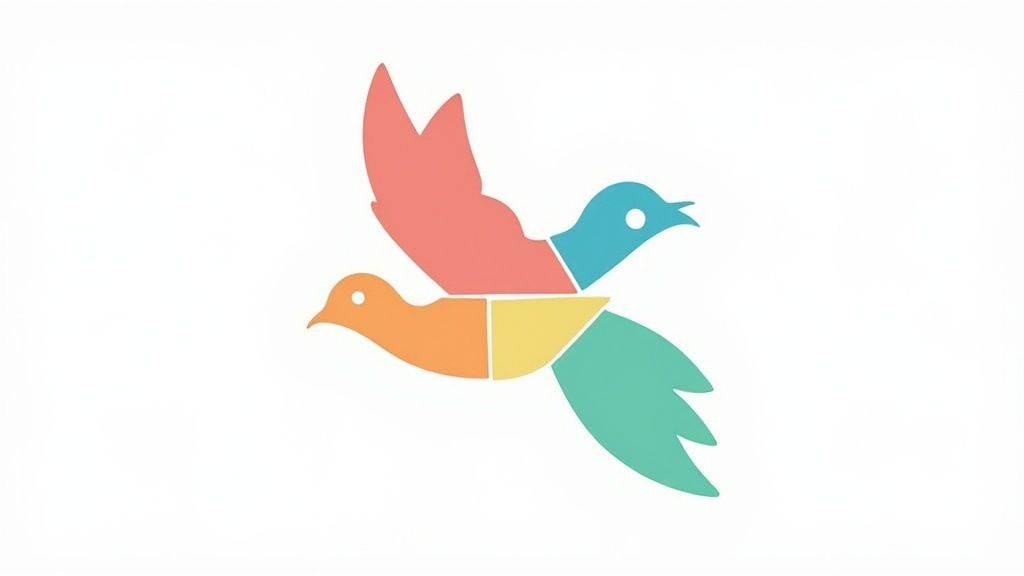
Engaging with tangrams directly targets critical perceptual abilities. It requires strong figure-ground perception to see how individual tans fit within the target outline. It also hones visual discrimination as you differentiate between the various triangles, and it sharpens spatial reasoning by forcing you to mentally rotate and position shapes before physically moving them. The process of recreating a complex shape from simple parts is a fantastic workout for problem-solving and visual memory.
Why This Works So Well
Tangrams are effective because they bridge the gap between abstract thinking and concrete action. They make geometric principles tangible and intuitive, which is why they are used so effectively in diverse settings. For instance, Chinese schools often use traditional tangrams to introduce foundational math concepts. In occupational therapy, they are used with stroke survivors to help rebuild neural pathways related to spatial awareness and fine motor control. Modern puzzle companies like ThinkFun have also popularized them in STEM education to teach logic and creativity.
Actionable Tips for Getting Started
To introduce tangrams effectively, consider these strategies:
- Begin with Simple Shapes: Start with puzzles that have clear internal lines showing how the pieces fit, before moving on to solid silhouettes. This helps learners understand the basic relationships between the shapes.
- Use Colored Tangram Sets: Brightly colored sets make it easier to distinguish between the seven tans, reducing frustration and making the activity more visually appealing, especially for children.
- Create Stories: Encourage storytelling around the completed figures. If you build a cat, ask, "What is the cat doing?" or "Where does it live?" This adds a layer of creative expression and context.
- Explore Digital Versions: Many excellent tangram apps are available for tablets and smartphones. These often provide hints and a wider variety of puzzles, making them a great tool for on-the-go practice.
3. The Thrill of the Hunt: Hidden Pictures Activities
Hidden picture puzzles are classic and powerful activities for visual perception that challenge the brain to find specific objects cleverly concealed within a larger, more complex illustration. Far from just being a way to pass the time, these puzzles are a targeted workout for the visual system. They require the eyes and brain to work together to sift through distracting background information and isolate specific shapes, colors, and forms.
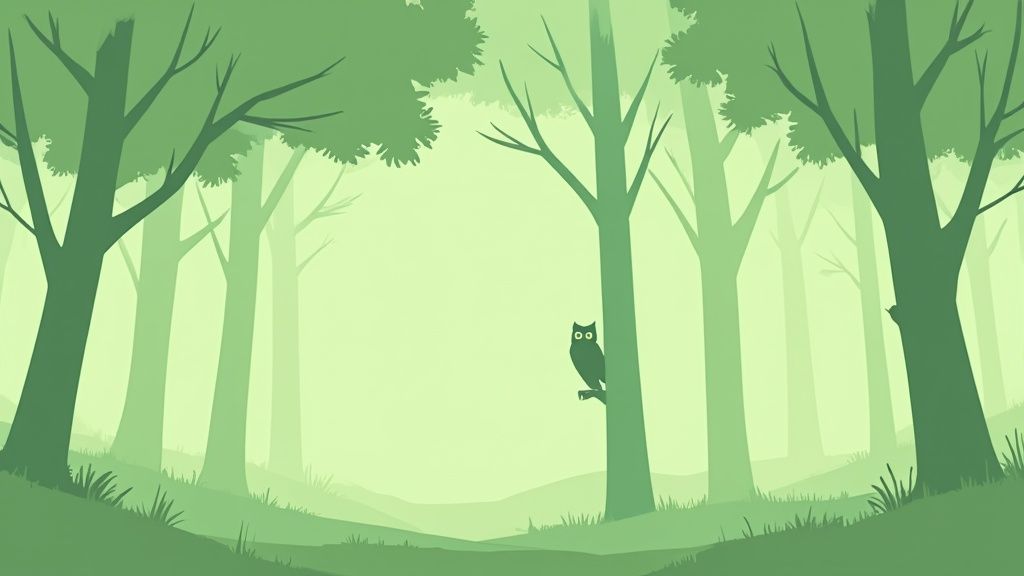
This engaging search process directly hones crucial skills like figure-ground perception (the ability to distinguish an object from its background), visual scanning (moving the eyes in a systematic way), and visual attention. Successfully finding a hidden item provides a satisfying "aha!" moment that reinforces focus and perseverance, making it an incredibly motivating activity for all ages.
Why This Works So Well
The effectiveness of hidden pictures lies in their ability to train the brain to manage visual clutter. In our visually noisy world, this is an essential life skill. These activities have been popularized for decades by mainstays like Highlights magazine and the Where's Waldo? and I Spy book series for a reason. They are staples in occupational therapy clinics to help children with visual processing disorders and in special education classrooms to improve attention and task completion skills. Similarly, for engaging activities that help sharpen observational skills in a real-world setting, consider interactive experiences like scavenger hunts for children, which are fantastic for young learners.
Actionable Tips for Getting Started
To turn a simple hidden picture puzzle into a targeted skill-building exercise, try these strategies:
- Scan Systematically: Encourage a structured search pattern, such as scanning from left to right and top to bottom, like reading a book. This prevents random, frantic searching and improves efficiency.
- Use a Pointer: Provide a fingertip, a small dowel, or an unsharpened pencil to guide the eyes. This helps maintain focus on one small area at a time and reduces visual overload.
- Reduce Visual Clutter: For particularly challenging puzzles, use a blank piece of paper to cover sections of the picture that have already been searched. This helps the eyes focus on the remaining area.
- Start Simple: Begin with puzzles that have fewer hidden objects and less background "noise." As skills improve, gradually move to more complex and crowded illustrations to build stamina and confidence.
4. Visual Memory Games
Visual memory games are some of the most direct and engaging activities for visual perception, specifically designed to train the brain's ability to retain and recall visual information. These games challenge individuals to look at a pattern, sequence, or arrangement of objects for a short time and then recreate it from memory. This process is a powerful workout for visual working memory, which is the mental workspace we use to hold onto images long enough to make sense of them.
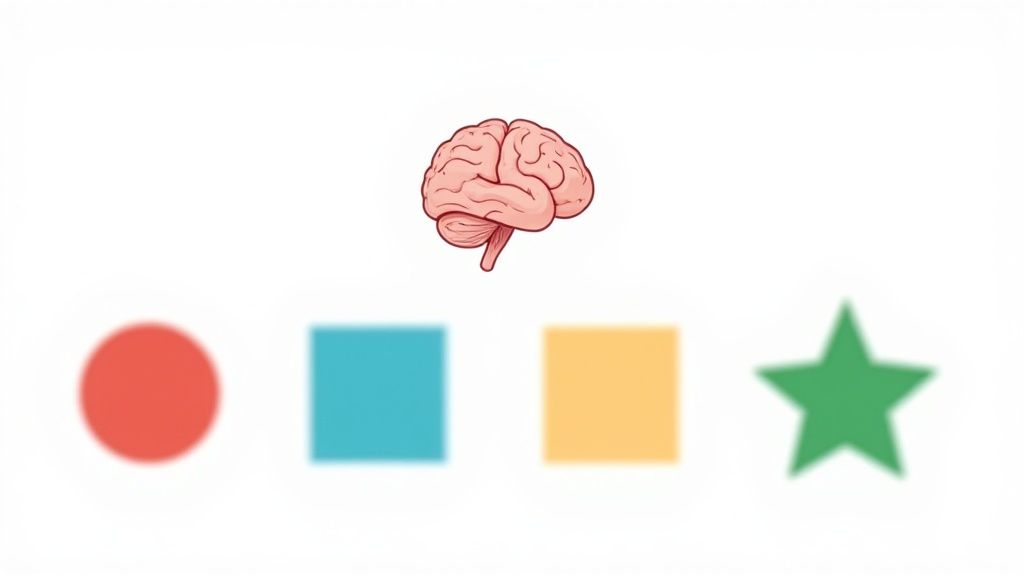
This "look, remember, and replicate" cycle directly strengthens crucial skills like visual attention (the ability to focus on important details), visual sequential memory (remembering the order of things), and visual recall. From the classic "What's Missing?" tray game to modern digital apps, these activities teach the brain to encode visual data quickly and accurately, a skill fundamental to reading, math, and everyday problem-solving.
Why This Works So Well
The effectiveness of visual memory games comes from their structured, repetitive nature, which systematically builds neural pathways for memory. This approach was famously commercialized by Ralph H. Baer with the electronic game Simon and has been refined by cognitive training companies like Lumosity and CogniFit. These games are widely used in therapeutic settings, such as in ADHD therapy to improve attention and in cognitive rehabilitation for older adults to maintain mental sharpness. By isolating and repeatedly exercising the visual memory system, these activities create lasting improvements in a fun, game-like context. For more insight into how these exercises support different learning styles, you can explore visual learning strategies on colorpage.ai.
Actionable Tips for Getting Started
To effectively incorporate visual memory games, try these proven methods:
- Start Small and Build Up: Begin with a simple game using just 3-4 items. Once that becomes easy, gradually increase the number of items or the complexity of the arrangement to continually challenge the brain.
- Use Chunking Strategies: Encourage grouping items together based on a common feature like color, shape, or category. This "chunking" technique makes it easier to remember larger sets of information.
- Create Story Associations: Weave a simple story or verbal narrative around the items to be remembered. Linking visual information to a story creates stronger, more memorable mental connections.
- Practice in Short Bursts: Aim for short, focused sessions of 10-15 minutes daily. Consistent, brief practice is far more effective for long-term retention than infrequent, long sessions.
5. Follow the Path: The Focus of Dot-to-Dot Activities
Dot-to-dot puzzles are classic, engaging activities for visual perception that go far beyond simple connect-the-dots fun. These exercises, which involve connecting a sequence of numbered or lettered dots to reveal a hidden picture, are a fantastic way to build foundational visual skills. They require the brain to track a path, anticipate the next step, and coordinate hand movements with visual cues, all while reinforcing basic academic concepts like number and letter order.
The act of linking one dot to the next directly strengthens several critical abilities. It enhances visual-motor integration by forcing the eyes and hands to work together with precision. It also develops sequencing skills (following a specific order) and spatial awareness (understanding where the next dot is in relation to the previous one). This makes dot-to-dots a powerful tool for preparing children for more complex tasks like handwriting.
Why This Works So Well
Dot-to-dots are effective because they provide a clear, structured goal with an immediate reward: a completed picture. This built-in motivation encourages persistence and focus. Publishers like Dover Publications and magazines such as Highlights for Children have popularized these puzzles for decades because they successfully merge play with learning. In an occupational therapy setting, a child might complete a dot-to-dot on a vertical surface to build shoulder stability for writing. Similarly, in a preschool classroom, it serves as a hands-on way to practice number recognition far more engagingly than a standard worksheet.
Actionable Tips for Getting Started
To maximize the benefits of dot-to-dot activities, try these targeted tips:
- Start Simple: Begin with puzzles that have fewer than 20 dots and a clear numerical sequence to build confidence and prevent frustration.
- Encourage Slow, Deliberate Lines: Instead of rushing, prompt the user to draw a slow, controlled line from one dot to the next. This better develops fine motor control.
- Use Thick or Colorful Markers: A thick pencil, crayon, or vibrant marker provides better grip and makes the connecting line more visible, which helps maintain visual focus.
- Go Vertical: Tape the activity sheet to a wall or easel. Working on a vertical surface strengthens the shoulder and wrist muscles necessary for proper handwriting posture.
6. Perceptual Matching Tasks
Perceptual matching tasks are classic activities for visual perception that sharpen the brain's ability to identify identical or similar items within a field of distractors. These exercises challenge individuals to quickly and accurately compare visual characteristics, from simple shapes and colors to complex patterns and orientations. By engaging in these tasks, users directly train their visual discrimination skills, boost attention to detail, and enhance their overall visual processing speed.
This type of activity is fundamental to how we navigate the world, from finding a specific brand on a crowded supermarket shelf to recognizing a friend's face in a crowd. It strengthens key skills like figure-ground perception (isolating an object from its background), visual memory (holding an image in mind to compare it), and visual scanning (systematically searching an area). These targeted exercises are designed to make the brain more efficient at filtering out irrelevant visual noise and homing in on what's important.
Why This Works So Well
The effectiveness of perceptual matching lies in its direct, focused approach to training a core cognitive function. It's a foundational skill that is often measured in formal assessments, such as the Test of Visual Perceptual Skills (TVPS), and is a cornerstone of occupational therapy programs. For example, a therapist might use matching worksheets to help a child with a learning disability improve their ability to distinguish between similar letters like 'b' and 'd'. Similarly, computer-based cognitive training programs use these tasks to help adults maintain sharp cognitive function. This method bridges the gap between assessment and practical, skill-building intervention. These exercises are also a key component in broader therapeutic approaches; you can explore similar techniques in cognitive stimulation therapy activities on colorpage.ai.
Actionable Tips for Getting Started
To effectively use perceptual matching tasks, consider these practical strategies:
- Adopt a System: Encourage a systematic left-to-right, top-to-bottom scanning approach, just like reading a book. This prevents random searching and ensures no items are missed.
- Start Simple, Build Complexity: Begin with tasks that have obvious differences, like matching large, brightly colored shapes. Gradually move to more subtle challenges, such as finding identical symbols with slight rotational differences.
- Use a Pointer: Using a finger or a physical pointer to track along rows can significantly improve focus and help maintain one's place, reducing visual fatigue and frustration.
- Ensure Good Lighting: Practice in a well-lit environment without glare. Proper lighting reduces eye strain and makes it easier to discern fine details, leading to better performance and less frustration.
7. Block Design Construction
Block Design Construction is one of the quintessential activities for visual perception that directly bridges the gap between seeing and doing. This activity involves recreating a two-dimensional visual pattern using a set of colored cubes or blocks. Participants look at a design card and must arrange their blocks to precisely match the image, a task that demands intense visual analysis and spatial reasoning. By translating a flat picture into a three-dimensional object, individuals train their brains to deconstruct complex images and understand part-to-whole relationships.
This process is a workout for several key perceptual skills. It sharpens visual-spatial reasoning (understanding where objects are in space), visual analysis (breaking down a design into its component parts), and figure-ground perception (focusing on the relevant shapes while ignoring distracting background details). The hands-on nature also refines the visual-motor skills needed to manipulate the blocks accurately, a foundational skill for handwriting and other daily tasks. Learn more about how these activities support growth.
Why This Works So Well
The power of block design lies in its structured and measurable challenge. It's a core subtest in major cognitive assessments, like the Wechsler Intelligence Scales, because it is a reliable indicator of non-verbal reasoning and problem-solving abilities. Its origins can be traced back to educational pioneers like Froebel, who used blocks to teach foundational geometric concepts. Today, it’s a staple in occupational therapy for building visual processing speed and in STEM programs to introduce engineering and architectural thinking in a concrete, accessible way.
Actionable Tips for Getting Started
To effectively introduce block design construction, try these strategies:
- Start with Simple Designs: Begin with easy 2x2 patterns using just four blocks. This helps build foundational confidence and teaches the basic principles of orientation and placement.
- Break Down Complex Patterns: For more intricate designs, encourage the user to tackle one section at a time. Covering part of the pattern card can help reduce visual overload and make the task more manageable.
- Use Edge Pieces as Anchors: Teach the strategy of identifying and placing the corner or edge blocks first. These pieces serve as reference points that make it easier to fill in the rest of the design.
- Encourage a Systematic Approach: Instead of random guessing, promote a trial-and-error method where each placement is deliberately checked against the pattern. Ask, "Does this block match the picture? What needs to change?"
Visual Perception Activities Comparison
| Activity | Implementation Complexity 🔄 | Resource Requirements ⚡ | Expected Outcomes 📊 | Ideal Use Cases 💡 | Key Advantages ⭐ |
|---|---|---|---|---|---|
| Pattern Block Activities | Moderate - requires supervision and care | Moderate - quality sets can be costly | Spatial reasoning, shape recognition, creativity | Montessori, OT clinics, special ed, early STEM | Builds foundational math; enhances coordination |
| Tangram Puzzles | Moderate - involves understanding 7-piece sets | Low - usually portable and simple sets | Spatial intelligence, problem-solving, patience | Schools, therapy, STEM programs, team-building | Highly effective spatial skill development |
| Hidden Pictures Activities | Low - simple execution, but can be complex visually | Low - mainly printed or digital material | Visual scanning, attention, figure-ground skills | Magazines, OT, special ed, therapeutic entertainment | Improves attention; fun and engaging |
| Visual Memory Games | Moderate - timed exposure and recall sequences | Low to moderate - can be digital or physical | Working memory, attention span, recall speed | Cognitive training, ADHD therapy, brain apps | Strong memory enhancement; adaptable skill levels |
| Dot-to-Dot Activities | Low - simple sequential connecting exercises | Low - printed books or sheets | Visual-motor integration, sequencing, fine motor | OT, preschool, special ed, home activities | Builds motor control; reinforces sequencing |
| Perceptual Matching Tasks | Low to moderate - repetitive but straightforward | Low - paper or digital | Processing speed, visual discrimination, attention | Assessments, cognitive training, educational software | Enhances processing speed; easily measurable |
| Block Design Construction | Moderate to high - complex spatial construction | Moderate - requires colored blocks | Spatial reasoning, visual analysis, problem-solving | Intelligence testing, Montessori, OT, STEM education | Develops strong spatial and analytical skills |
Making Visual Perception a Fun Part of Everyday Life
We've explored a fantastic collection of engaging, hands-on activities, from the geometric creativity of Tangram Puzzles and Pattern Blocks to the focused challenge of Hidden Pictures and Dot-to-Dot. Each of these seven methods offers a unique pathway to strengthening the complex skills that fall under the umbrella of visual perception. But the real magic isn't in mastering any single activity; it's in recognizing that you now have a versatile toolkit to pull from.
The journey to sharpen these abilities doesn't have to feel like a structured lesson plan or a chore. Instead, think of it as weaving moments of playful focus into your daily routine. The core takeaway is that consistency, not intensity, is what builds lasting skills. A few minutes with a block design challenge or a quick visual memory game can be more impactful than one long, overwhelming session.
Key Takeaways for Your Visual Perception Toolkit
Remember that the benefits of these activities extend far beyond just "getting better at puzzles." By integrating them into playtime, therapy sessions, or classroom learning, you're directly supporting crucial developmental milestones.
- Boost Academic Readiness: Skills like visual discrimination (telling 'b' from 'd') and spatial awareness (understanding charts and graphs) are foundational for reading, writing, and mathematics.
- Enhance Problem-Solving: Activities like block construction and Tangrams teach individuals to visualize solutions, mentally rotate objects, and break down complex problems into smaller, manageable steps.
- Improve Focus and Attention: Finding hidden objects or completing a detailed dot-to-dot puzzle requires sustained concentration, training the brain to filter out distractions and pay attention to detail.
Putting It All into Practice
The best approach is a personalized one. Mix and match these activities for visual perception based on interest and specific needs. Is the goal to improve figure-ground perception? Hidden Pictures is your go-to. Need to work on spatial relations? Break out the Pattern Blocks.
For parents and educators, this variety is especially powerful. When looking for ways to reduce screen time, many find that engaging screen-free alternatives for children naturally incorporate these very same perceptual skills. The key is to present them as fun, collaborative experiences. By turning these tasks into games and enjoyable challenges, you create a positive, low-pressure environment where visual skills can flourish organically, setting a strong foundation for a lifetime of learning and discovery.
Ready to create your own custom visual perception activities? With ColorPageAI, you can generate endless unique coloring pages, dot-to-dot puzzles, and pattern sheets tailored to any theme or skill level. Turn your ideas into high-quality, printable resources in seconds by visiting ColorPageAI today
Ready to start coloring?
Join ColorPage.ai today and get 5 free credits to create your own custom coloring pages!
Start creating